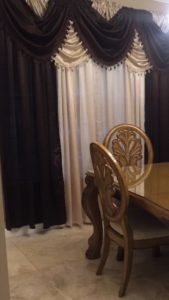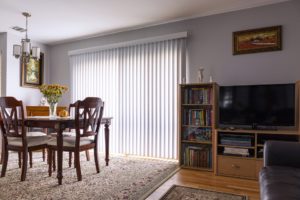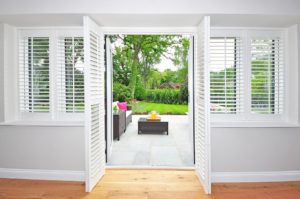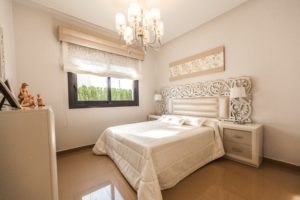I mentioned in a previous post that my husband bought these beautiful French doors on Craigslist. What I didn’t tell you is that he bought four sets of them. Granted, he did this to convert the sliding glass doors we had into hurricane impact doors, but now I had a real dilemma. One became our front doors (the bottom set of doors below), so I had to figure out how to get us some privacy first. The other three were situated like this:
The side with two to the patio was open to anyone walking by; the other side had a privacy fence between our neighbors and us, so that wasn’t as important, but I wanted some kind of cohesion in my decorating theme. Research time!
Out of all the different sites I visited I found these as the five ways most commonly used by homeowners to cover their glass doors while adding some pizzazz to their homes.
Drapes

Drapes add drama to a room. I think drapes and immediately the curtains in a theater come to mind. Going back to my roots! But seriously, drapes don’t just finish a room, they can totally change the mood. Depending on the fabric, texture, weight and print, they can can lighten the mood or evoke an air of mystery.
Things to consider when thinking about drapes:
- Amount of wall space it will cover. For me, I had three huge doors to cover, so if I decorated with drapes, they would pretty much be the focal points of the living room.
- The purpose of the drapes. Would it be to block light completely, or to just filter the light a bit? Are they to be used to keep the heat out, or are they just decorative?
- Knowing the purpose, you would have an idea of the type of material you want. Materials like silk, faux silk, linen and velvet all fall or hang well. A material like velvet would help block the sun more than the others, unless they are lined.
- How often will they be drawn? If a lot you will need a fabric that is a little more durable.
- Colors and prints are the icing on the cake with drapes, but keep in mind that if you live in a hot place like I do, the sun will wear the colors down. You don’t want one set fading while the other stays pristine.
- Budget is a big one here. If you are doing drapes, are you adding a valance to it? How many panels would you need to cover the space properly? Are you going pre-made, store bought panels or are you having them custom made? You can go from a $200 project to a $2,000 project in no time.
- Allergens – if you have someone in your home who has environmental allergies (such as dust mites)this may not be the best option. Taking drapes down, washing and rehanging constantly is a nightmare, as I have found myself!
Blinds

Just as with drapes, blinds have a different connotation to me. Cheap and easy. Things to consider when buying blinds:
- Safety – In my research, I’ve found that blinds have come a long way from the cheap aluminum blinds with long cords that were just accidents waiting to happen! In January 2018, the Window Covering Manufacturer’s Association announced a new safety standard that requires a vast majority of window covering products sold in the U.S. and Canada to be “cordless or have inaccessible or short cords.” This is great news, especially if you are considering blinds for a doorway.
- How often will you be using the doors? This can affect what type of blinds you will buy. Different options are:
- If you have French doors which are used a lot, you should think about buying two sets of blinds, one for each door. You would install them over the glass panels, not the entire door.
- If you have sliding glass doors that you use a lot, vertical blinds are great to cover the entire doorway. Make sure the blinds you use can handle wear and tear. Different materials you can choose from are wood, faux wood, fabric, vinyl and aluminum.
- How will they look from the outside? If you choose to install blinds to your front doors, or anywhere to the front of the house, make sure you like the view from the outside, because that is what you will be looking at for years to come. You want to add curb appeal.
Shutters

If you want something that looks more permanent, shutters are a good option. When installed properly, they can add significant value to the home. The look is timeless, elegant and polished. Think about the following when considering shutters:
- What kind of material do you want to use? Depending on your budget, you can choose hardwood (higher end) to polysatin or PVC shutters (lower end), to a combination/hybrid of materials. Your options your choices of materials will depend on who you do business with. Many people choose wood over synthetic material because:
- Wood is lighter and so requires let slats/panels. This allows more light to filter in and increases your outside view.
- Wood can be painted any color you choose to match your taste, but the polysatin and hybrid shutters come in limited colors like white, off-white and wood colors.
- Midrail – You do not have to have this on your door, but it is a good option. A midrail is the horizontal plank that is in the middle of the shutter panel. This panel allows you to open the top and bottom shutter portions independently of each other. It also adds strength to the shutter and keeps it from warping.
- Tilt rod – This is the vertical mechanism that operates the opening and closing of the shutters. You can choose to have them centrally on the panel, offset or hidden (at an added cost).
- Opening and closing of the shutters. You can install shutters on a track, with different options for opening: allowing them to slide open and closed through a bi-fold or using a bi-pass track system. Bi-fold shutters fold back much like a closet door. By-pass doors slide past each other to the front or behind.
Shades

There are many different types of shades you can use for a door:
- Cellular Shades – They are also known as honeycomb shades because from the side they look like a honeycomb. They are the easiest to clean out of fabric shades. They provide better insulation than most window coverings and when opened fully, there is minimal blockage of the doors. I will say this about cellular shades. When we moved in to our house, the sliding glass doors had these shades. While they were beautiful, they were difficult to roll up because they were manual shades. When you are trying to cover a big space like a door, you need to have something cordless, preferably motorized. It will be a little more costly, but it will save you a lot of headache, especially if you use the doors a lot. Also look into the vertical cellular shades, which are awesome for sliding doors.
- Roman Shades – These also block out the sun, but not as effectively as cellular shades. They are more lightweight and are mostly made from fabric but you sometimes will see bamboo Roman shades are basically a flat piece of fabric that can be pulled up by some mechanism, such as a cord system. There are also ‘Constructed Roman Shades,’ which are panels of fabric/bamboo sewn together and reinforced for better durability. These may be a little difficult to maneuver with sliding glass doors but you could mount them over the glass panels of French doors, adding a relaxed style.
- Sliding Panels – These are a contemporary alternative to vertical blinds. The best way to use them is on big windows or glass doors; you can even use them as a room divider if hung from a ceiling track! They can stack totally clear of the door when opened and come in many different types of fabric, solar screen or woven wood materials.
Decorating the Glass
How about actually turning the glass on the door from transparent to opaque? The following are some techniques you can use to do just that:
- Frosting – You can add add a design or keep it simple. This is how I frosted my front doors with frosting spray. If you don’t want to go through the mess and headache of doing it yourself, you can also purchase frosted window film in different designs.
- Etching – Another idea is using etching cream to create a different sort of look, such as rain on glass effect.
- Stained glass – Believe it or not, by using liquid leading you can create a stained glass effect on your doors. If you want to, you can also use film for the glass much like the frosting film.
I know all of this is a lot to think about. I will do more posts going into more detail on each of these methods. One of the projects on my bucket list is to make my own drapes and have them look as though I had them professionally installed (unlike the store bought ones I have above that are not the same length! Don’t think I didn’t notice!)
I love the idea of doing shutters for my son’s bedroom, because I can easily clean them; he is allergic to dust mites. I will also be looking into getting the vertical sliding panels for my bedroom doors. Any ideas? Let me know!


